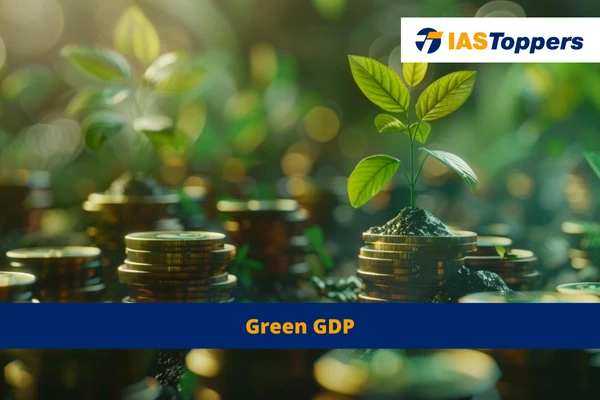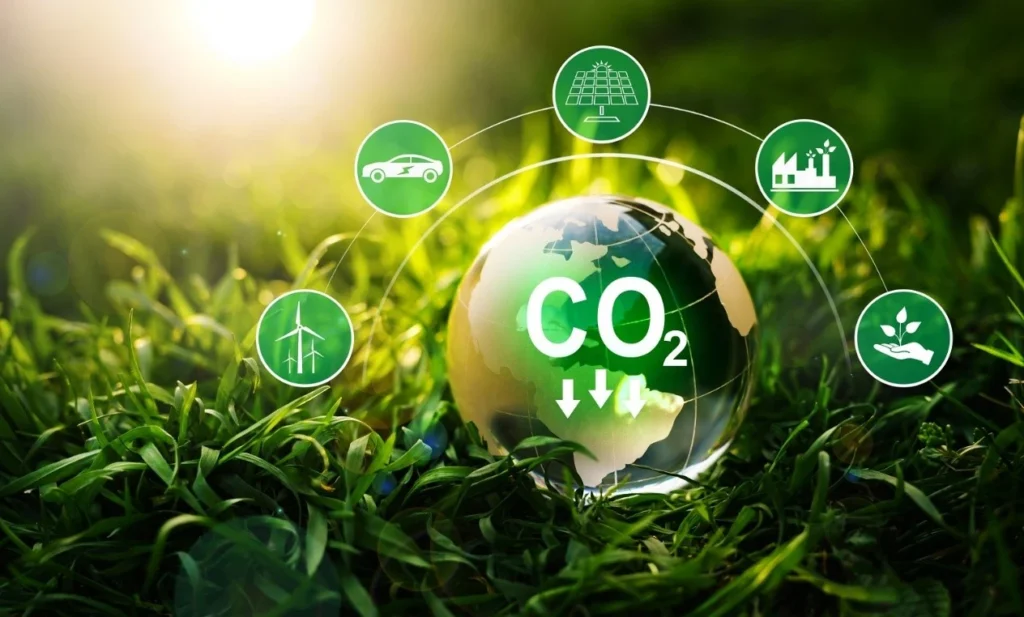Green GDP is an innovative economic metric that integrates environmental health and ecosystem sustainability with traditional economic indicators to provide a more comprehensive view of a nation’s economic performance. Unlike the conventional GDP, which measures the total value of all goods and services produced over a specific time period, Green GDP accounts for the cost of environmental damage and the depletion of natural resources. In this, you will learn about Green GDP, its significance, challenges, solutions, etc.
This article will provide key insights for GS Paper- III Environment, ecology and disaster management of UPSC IAS Exam.
Table of Content
- What is Green GDP?
- Significance of Green GDP
- Challenges in Implementing Green GDP
- Global Examples
- How Green GDP can be implemented in India?
- Conclusion
- FAQs on Green GDP
What is Green GDP?
- Green GDP (gross domestic product) is an indicator that subtracts the cost of natural resource depletion and environmental degradation from the conventional GDP of a country.
- Green GDP = GDP − Environmental Costs − Social Costs
- It monetizes the loss of biodiversity, and accounts for costs caused by climate change.
- It is also known as environmentally adjusted domestic product.
- It shows the sustainability of economic growth and its impact on people’s well-being.
Significance of Green GDP
- Reflects Environmental Costs: Green GDP accounts for the environmental costs associated with economic growth, such as pollution and resource depletion, this helps policymakers understand the true impact of economic activities on the environment.
- Encourages Sustainable Practices: By highlighting the environmental costs of economic activities, Green GDP encourages businesses and governments to adopt more sustainable practices and invest in green technologies.
- Provides a Comprehensive Economic Measure: Green GDP integrates environmental health into economic planning, ensuring that economic policies do not compromise with environmental sustainability.
- Promotes Long-term Economic Stability: By accounting for environmental degradation, Green GDP promotes long-term economic stability, as it ensures that natural resources are managed sustainably for future generations.
- Supports International Environmental Goals: Green GDP aligns with international environmental goals, such as the UN Sustainable Development Goals (SDGs), by promoting economic activities that are environmentally sustainable.
Challenges in Implementing Green GDP
- Data Collection: There is difficulty in gathering reliable and comprehensive environmental data, with estimation involves assumptions and subjective judgments, affecting reliability and comparability.
- Valuation Methods: There is complexity in assigning economic value to environmental degradation and resource depletion as certain aspects of the environment, such as biodiversity, have intrinsic value that cannot be adequately captured by such methods.
- Standardization: Lack of standardized methods and frameworks for calculating Green GDP.
- Economic Impact: Potential resistance due to perceived negative impact on traditional economic growth figures.
Global Examples
- China: One of the first countries to experiment with Green GDP in the early 2000s, but it faced challenges.
- US: It has developed a system of environmental-economic accounts that provides indicators on economy-environment interactions, environmental expenditures, and taxes. It does not produce a single Green GDP measure.
- Norway: It has integrated environmental considerations into its national accounting system.
- European Union: It promotes the use of environmental indicators alongside traditional GDP among its member states by encouraging compilation of accounts covering emissions, taxes, materials, and protection expenditure.
- Sweden: Top performer in the Global Green Economy Index, it has developed a dashboard of indicators to monitor progress towards green growth. It measures performance based on leadership and climate change, efficiency sectors, markets and investment, and environment and natural capital.
- India: Green GDP is not officially measured or reported in India, but earlier some attempts have been made to estimate it by various researchers and institutions.
How Green GDP can be implemented in India?
- Policy Formulation and Integration: Establish regulations that mandate the inclusion of environmental costs in the calculation of GDP.
- Institutional Reforms: Create a dedicated government body or task force to oversee the integration of Green GDP into national accounting systems.
- Data Collection and Management: Ensure data accuracy & transparency by adopting international standards for environmental statistics & accounting. Implement mechanisms to collect comprehensive environmental data, such as natural resource usage, etc.
- Adoption of Advanced Methodologies: Utilize advanced technologies and methodologies, such as remote sensing, GIS, and ecological modeling, for accurate environmental valuation.
- Economic Incentives & Disincentives: Introduce economic incentives for businesses and industries that adopt sustainable practices and implement disincentives, such as higher taxes, for activities that cause significant environmental damage.
- Regular Monitoring and Evaluation: Publish annual reports on Green GDP and establish a system for regular monitoring and evaluation of Green GDP implementation progress.
Conclusion
The concept of “Green GDP” holds significant relevance in contemporary economic discourse, particularly in the context of sustainable development. By incorporating environmental factors into traditional GDP calculations, Green GDP offers a more comprehensive measure of economic progress that accounts for the true costs of growth, including environmental degradation and resource depletion.
In conclusion, adopting Green GDP as a metric for economic evaluation can help policymakers make informed decisions that prioritize sustainability and environmental conservation alongside economic growth. This approach promotes a more balanced and holistic understanding of development, ensuring that future generations can inherit a planet that is not only economically prosperous but also environmentally sustainable.
Ref:Source-1
| Other Articles in Environment & Disaster Management | |
| Carbon Foot Print | UNREDD and UN REDD+ |
| Environmental Impact Assessment (EIA) | Compensatory Afforestation |
| National Green Tribunal | In-situ conservation |
FAQs (Frequently Asked Questions)
What is Green National Account (GNA)?
GNA integrates environmental considerations into national accounting frameworks. It measures and accounts for environmental costs and benefits of economic activities. It captures the value of natural resources, pollution costs, environmental degradation, and ecosystem services benefits.
What are some examples of environmental costs?
Examples of environmental costs includes pollution, resource depletion, habitat destruction, climate change, waste generation, etc.
What are some examples of environmental benefits?
Examples of environmental benefits includes ecosystem services (e.g., food provision, water purification, climate regulation), biodiversity conservation, renewable energy adoption, sustainable agriculture practices and conservation and restoration efforts.
What is Global Green Economy Index (GGEI)?
It is a measure of the green economy performance of 160 countries, that aims to provide a transparent measure of country sustainability performance by using 4 indicators- climate change & social equity, sector decarbonization, markets & investment and environmental health.
What is the difference between Green GDP and GDP?
The Green GDP considers how economic growth would affect the environment and is thus a modified form of initial GDP by making the costs of climate change, biodiversity loss, carbon emissions, and other issues monetary.



